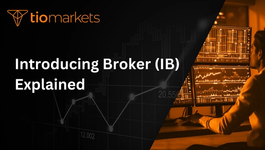Expected shortfall: Explained | TIOmarkets
BY TIOmarkets
|July 8, 2024In the world of trading, risk management is paramount. One of the key metrics used in assessing risk is the Expected Shortfall (ES). This concept, also known as Conditional Value at Risk (CVaR), is a risk measure that quantifies the expected loss that could occur in an investment portfolio, given that a certain threshold of losses has already been surpassed. This article will delve into the intricacies of Expected Shortfall, providing a comprehensive understanding of this crucial risk measure.
Expected Shortfall is a more comprehensive risk measure than Value at Risk (VaR), as it takes into account the severity of losses beyond the VaR threshold. This makes it a more accurate and reliable measure for assessing portfolio risk, particularly in times of market stress. The following sections will break down the concept of Expected Shortfall, its calculation, its application in trading, and its advantages and disadvantages.
Understanding Expected Shortfall
Expected Shortfall is a statistical measure that quantifies the potential loss in value of a risky portfolio or investment over a specified time period. It is used to estimate the potential losses that could occur in extreme market conditions, providing a worst-case scenario estimate. This measure is particularly useful for risk-averse investors and traders, as it provides an indication of the potential downside risk of an investment.
Unlike VaR, which only provides an estimate of the maximum potential loss within a certain confidence level, Expected Shortfall takes into account the losses that could occur beyond this level. In other words, it provides an estimate of the average loss that could occur in the worst-case scenarios. This makes it a more robust measure of risk, particularly for portfolios with non-normal return distributions or those subject to extreme market events.
Expected Shortfall vs Value at Risk
While both Expected Shortfall and Value at Risk are used to quantify the potential losses in a portfolio, they differ in their approach. VaR provides an estimate of the maximum potential loss within a certain confidence level, but it does not provide any information about the losses that could occur beyond this level. This is known as the 'tail risk' and can be particularly significant in times of market stress.
Expected Shortfall, on the other hand, provides an estimate of the average loss that could occur in the worst-case scenarios, taking into account the tail risk. This makes it a more comprehensive measure of risk, particularly for portfolios with non-normal return distributions or those subject to extreme market events. However, it is also more complex to calculate and interpret than VaR.
Calculating Expected Shortfall
The calculation of Expected Shortfall involves several steps. First, the return distribution of the portfolio is estimated, typically using historical data. Then, the VaR is calculated for a specified confidence level. Finally, the Expected Shortfall is calculated as the average loss that could occur beyond the VaR threshold.
The calculation of Expected Shortfall can be complex, particularly for portfolios with non-normal return distributions. However, there are several software packages and online tools available that can simplify the process. It is also important to note that the accuracy of the Expected Shortfall estimate depends on the accuracy of the return distribution estimate and the chosen confidence level.
Return Distribution
The first step in calculating Expected Shortfall is to estimate the return distribution of the portfolio. This is typically done using historical data, although other methods such as Monte Carlo simulations can also be used. The return distribution provides an indication of the likelihood of different return outcomes, which is crucial for estimating the potential losses in a portfolio.
It is important to note that the accuracy of the return distribution estimate is crucial for the accuracy of the Expected Shortfall estimate. If the return distribution is not accurately estimated, the Expected Shortfall estimate may be misleading. Therefore, it is important to use a sufficient amount of high-quality data and to regularly update the return distribution estimate to reflect recent market conditions.
Value at Risk
The second step in calculating Expected Shortfall is to calculate the Value at Risk (VaR) for a specified confidence level. The VaR is the maximum potential loss that could occur within a certain confidence level, based on the return distribution. It provides a threshold for the potential losses in a portfolio, which is used to calculate the Expected Shortfall.
The VaR can be calculated using several methods, including the historical method, the variance-covariance method, and the Monte Carlo method. The choice of method depends on the characteristics of the portfolio and the available data. It is important to note that the VaR is only an estimate and that actual losses could exceed the VaR, particularly in times of market stress.
Application of Expected Shortfall in Trading
Expected Shortfall is widely used in trading to assess the risk of investment portfolios. It provides a measure of the potential losses that could occur in extreme market conditions, which is crucial for risk management. By quantifying the potential downside risk, Expected Shortfall helps traders to make informed decisions about their investment strategies.
Expected Shortfall is particularly useful for risk-averse traders, as it provides an indication of the potential losses in the worst-case scenarios. This can help traders to manage their risk exposure and to set appropriate stop-loss levels. It can also be used to compare the risk of different investment strategies or portfolios, helping traders to choose the most suitable option for their risk tolerance.
Risk Management
One of the main applications of Expected Shortfall is in risk management. By quantifying the potential downside risk, Expected Shortfall helps traders to manage their risk exposure. This can involve setting appropriate stop-loss levels, diversifying the portfolio, or adjusting the investment strategy to reduce the potential losses.
Expected Shortfall is particularly useful for risk-averse traders, as it provides an indication of the potential losses in the worst-case scenarios. This can help traders to avoid investments with high downside risk, or to take measures to mitigate this risk. It can also help traders to manage their risk exposure in times of market stress, when the potential losses can be particularly high.
Investment Strategy
Expected Shortfall can also be used to inform the investment strategy. By comparing the Expected Shortfall of different investment strategies or portfolios, traders can choose the option that best suits their risk tolerance. This can involve choosing a strategy with a lower Expected Shortfall, or diversifying the portfolio to reduce the potential losses.
Expected Shortfall can also be used to assess the risk-return trade-off of different investment strategies. A strategy with a high Expected Shortfall may offer higher potential returns, but it also carries a higher risk. Therefore, traders need to balance the potential returns against the potential losses, taking into account their risk tolerance and investment goals.
Advantages of Expected Shortfall
Expected Shortfall has several advantages as a risk measure. First, it takes into account the severity of losses beyond the VaR threshold, making it a more comprehensive measure of risk. Second, it provides an estimate of the average loss in the worst-case scenarios, which is more informative than the maximum potential loss provided by VaR. Third, it is a coherent risk measure, meaning that it satisfies certain mathematical properties that make it suitable for risk management.
Another advantage of Expected Shortfall is that it can be used to assess the risk of non-normal return distributions, which are common in financial markets. This makes it a more accurate and reliable measure of risk for portfolios subject to extreme market events. However, it is also more complex to calculate and interpret than VaR, which can be a disadvantage for some traders.
Comprehensive Risk Measure
One of the main advantages of Expected Shortfall is that it is a more comprehensive measure of risk than VaR. While VaR only provides an estimate of the maximum potential loss within a certain confidence level, Expected Shortfall takes into account the losses that could occur beyond this level. This makes it a more accurate and reliable measure of risk, particularly for portfolios with non-normal return distributions or those subject to extreme market events.
By taking into account the tail risk, Expected Shortfall provides a worst-case scenario estimate that is more informative than the maximum potential loss provided by VaR. This can help traders to manage their risk exposure and to make informed decisions about their investment strategies. However, it is also more complex to calculate and interpret than VaR, which can be a disadvantage for some traders.
Coherent Risk Measure
Another advantage of Expected Shortfall is that it is a coherent risk measure. This means that it satisfies certain mathematical properties that make it suitable for risk management. These properties include monotonicity, sub-additivity, positive homogeneity, and translational invariance.
Monotonicity means that if one portfolio always results in a higher loss than another, its Expected Shortfall will be higher. Sub-additivity means that the Expected Shortfall of a combined portfolio is less than or equal to the sum of the Expected Shortfalls of the individual portfolios. Positive homogeneity means that the Expected Shortfall of a portfolio is proportional to the size of the portfolio. Translational invariance means that adding a risk-free asset to a portfolio reduces its Expected Shortfall by the same amount.
Disadvantages of Expected Shortfall
While Expected Shortfall has several advantages as a risk measure, it also has some disadvantages. First, it is more complex to calculate and interpret than VaR, which can be a disadvantage for some traders. Second, it relies on the accuracy of the return distribution estimate, which can be difficult to achieve, particularly for portfolios with non-normal return distributions. Third, it does not provide any information about the potential gains in a portfolio, only the potential losses.
Another disadvantage of Expected Shortfall is that it can be sensitive to the chosen confidence level. If the confidence level is set too high, the Expected Shortfall estimate may be overly pessimistic, leading to overly conservative investment decisions. On the other hand, if the confidence level is set too low, the Expected Shortfall estimate may be overly optimistic, leading to excessive risk-taking.
Complexity
One of the main disadvantages of Expected Shortfall is its complexity. While VaR is relatively simple to calculate and interpret, Expected Shortfall involves a more complex calculation process and requires a deeper understanding of statistical concepts. This can be a disadvantage for some traders, particularly those with limited statistical knowledge or resources.
Despite its complexity, there are several software packages and online tools available that can simplify the calculation of Expected Shortfall. However, it is important to understand the underlying concepts and assumptions, as misuse or misunderstanding of Expected Shortfall can lead to misleading results and poor investment decisions.
Dependence on Return Distribution
Another disadvantage of Expected Shortfall is that it relies on the accuracy of the return distribution estimate. If the return distribution is not accurately estimated, the Expected Shortfall estimate may be misleading. This can be particularly challenging for portfolios with non-normal return distributions, which are common in financial markets.
Despite this disadvantage, there are several methods available for estimating the return distribution, including historical data, parametric methods, and Monte Carlo simulations. It is also important to regularly update the return distribution estimate to reflect recent market conditions, and to use a sufficient amount of high-quality data to ensure the accuracy of the estimate.
Conclusion
Expected Shortfall is a powerful tool for assessing the risk of investment portfolios. By quantifying the potential losses in extreme market conditions, it provides a worst-case scenario estimate that is crucial for risk management. Despite its complexity and the challenges associated with estimating the return distribution, Expected Shortfall provides a more comprehensive and accurate measure of risk than VaR, making it a valuable tool for risk-averse traders and investors.
Whether you're a seasoned trader or a beginner, understanding Expected Shortfall can help you make informed decisions about your investment strategies and manage your risk exposure. By taking into account the potential losses in the worst-case scenarios, you can avoid investments with high downside risk, set appropriate stop-loss levels, and choose the investment strategy that best suits your risk tolerance and investment goals.
Take Control of Your Trading Risk with TIOmarkets
Now that you understand the importance of Expected Shortfall in managing your investment risks, it's time to apply this knowledge with a broker you can trust. TIOmarkets, a top-rated forex broker, offers you the platform to trade over 300 instruments across 5 markets, including Forex, indices, stocks, commodities, and futures, all with low fees. Join our community of 170,000+ traders in over 170 countries and enhance your trading skills with our comprehensive educational resources. Ready to take the next step? Create a Trading Account today and start trading with confidence.

Risk disclaimer: CFDs are complex instruments and come with a high risk of losing money rapidly due to leverage. You should consider whether you understand how CFDs work and whether you can afford to take the high risk of losing your money. Never deposit more than you are prepared to lose. Professional client’s losses can exceed their deposit. Please see our risk warning policy and seek independent professional advice if you do not fully understand. This information is not directed or intended for distribution to or use by residents of certain countries/jurisdictions including, but not limited to, USA & OFAC. The Company holds the right to alter the aforementioned list of countries at its own discretion.
Join us on social media

Behind every blog post lies the combined experience of the people working at TIOmarkets. We are a team of dedicated industry professionals and financial markets enthusiasts committed to providing you with trading education and financial markets commentary. Our goal is to help empower you with the knowledge you need to trade in the markets effectively.





